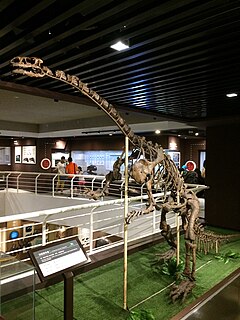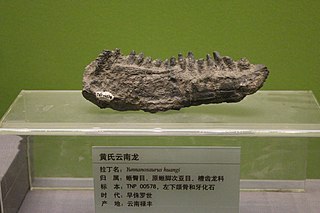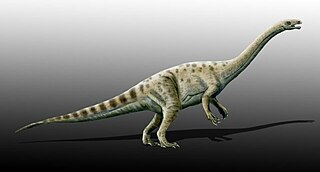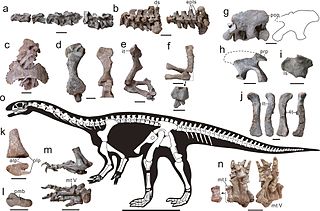
Anchisaurus is a genus of basal sauropodomorph dinosaur. It lived during the Early Jurassic Period, and its fossils have been found in the red sandstone of the Portland Formation, northeastern United States, which was deposited from the Hettangian age into the Sinemurian age, between about 200 and 195 million years ago. Until recently it was classed as a member of Prosauropoda. The genus name Anchisaurus comes from the Greek αγχιanchi-; "near, close" + Greek σαυρος ; "lizard". Anchisaurus was coined as a replacement name for "Amphisaurus", which was itself a replacement name for Hitchcock's "Megadactylus", both of which had already been used for other animals.

Massospondylus is a genus of sauropodomorph dinosaur from the Early Jurassic Period. It was described by Sir Richard Owen in 1854 from remains discovered in South Africa, and is thus one of the first dinosaurs to have been named. Fossils have since been found at other locations in South Africa, Lesotho, and Zimbabwe. Material from Arizona's Kayenta Formation, India, and Argentina has been assigned to this genus at various times, but the Arizonan and Argentinian material are now assigned to other genera.

Lufengosaurus is a genus of massospondylid dinosaur which lived during the Early Jurassic period in what is now southwestern China. A nearly intact lufengosaurus was found in May 2021 in Lufeng City, in the Province of Yunnan, in Southern China, by paleontologists and Wang Tao, Head of the Dinosaur Conservation and Research Center in Lufeng City. Again, the dinosaur made international headlines in 2017 when Nature Communications reported scientists' discovery of 195-million-year-old collagen protein in the rib of a Lufengosarus fossil.

Yunnanosaurus is an extinct genus of sauropodomorph dinosaur that lived approximately 201 to 168 million years ago in what is now the Yunnan Province, in China, for which it was named. Yunnanosaurus was a large sized, moderately-built, ground-dwelling, quadrupedal herbivore, that could also walk bipedally, and ranged in size from 7 meters (23 feet) long and 2 m (6.5 ft) high to 4 m (13 ft) high in the largest species.

Sinosaurus is an extinct genus of theropod dinosaur which lived during the Early Jurassic Period. It was a bipedal carnivore approximately 5.6 metres in length. Fossils of the animal were found at the Lufeng Formation, in the Yunnan Province of China.

Coloradisaurus is a genus of massospondylid sauropodomorph dinosaur. It lived during the Late Triassic period in what is now La Rioja Province, Argentina. It is known from two specimens collected from the Los Colorados Formation of the Ischigualasto-Villa Unión Basin.
Gigantoscelus is a dubious genus of basal sauropodomorph dinosaur from the Early Jurassic of South Africa.
Gryponyx is an extinct genus of massopod sauropodomorph known from southern Free State, central South Africa.

Hortalotarsus is a dubious genus of extinct sauropodomorph from Early Jurassic rocks of South Africa.
Chinshakiangosaurus is a genus of dinosaur and probably one of the most basal sauropods known. The only species, Chinshakiangosaurus chunghoensis, is known from a fragmentary skeleton found in Lower Jurassic rocks in China. Chinshakiangosaurus is one of the few basal sauropods with preserved skull bones and therefore important for the understanding of the early evolution of this group. It shows that early sauropods may have possessed fleshy cheeks.
Eshanosaurus is a genus of a dinosaur from the early Jurassic Period. It is known only from a fossil partial lower jawbone, found in China. It may be a therizinosaurian, and if so the earliest known coelurosaur.
Fulengia is a dubious genus of basal sauropodomorph dinosaur from the Early Jurassic Lufeng Formation of China.
Peter Malcolm Galton is an American vertebrate paleontologist who has to date written or co-written about 190 papers in scientific journals or chapters in paleontology textbooks, especially on ornithischian and prosauropod dinosaurs.

The Lufeng Formation is a Lower Jurassic sedimentary rock formation found in Yunnan, China. It has two units: the lower Dull Purplish Beds/Shawan Member are of Hettangian age, and Dark Red Beds/Zhangjia'ao Member are of Sinemurian age. It is known for its fossils of early dinosaurs. The Dull Purplish Beds have yielded the possible therizinosaur Eshanosaurus, the possible theropod Lukousaurus, and the "prosauropods" "Gyposaurus" sinensis, Lufengosaurus, Jingshanosaurus, and Yunnanosaurus. Dinosaurs discovered in the Dark Red Beds include the theropod Sinosaurus triassicus, the "prosauropods" "Gyposaurus", Lufengosaurus, and Yunnanosaurus, indeterminate remains of sauropods, and the early armored dinosaurs Bienosaurus and Tatisaurus.

Massospondylidae is a family of early massopod dinosaurs that existed in Asia, Africa, North America, South America and Antarctica during the Late Triassic to the Early Jurassic periods. Several dinosaurs have been classified as massospondylids over the years. The largest cladistic analysis of early sauropodomorphs, which was presented by Apaldetti and colleagues in November 2011, found Adeopapposaurus, Coloradisaurus, Glacialisaurus, Massospondylus, Leyesaurus and Lufengosaurus to be massospondylids. This result supports many previous analyses that tested fewer taxa. However, this analysis found the two recently described North American massopods, Sarahsaurus and Seitaad, and the South African Ignavusaurus to nest outside Massospondylidae, as opposed to some provisional proposals. Earlier in 2011, Pradhania, a sauropodomorph from India, was tested for the first time in a large cladistic analysis and was found to be a relatively basal massospondylid. Mussaurus and Xixiposaurus may also be included within Massospondylidae. In 2019, a specimen previously assigned to Massospondylus from South Africa was re-examined and found to belong to a separate genus that was named Ngwevu.

The Anchisauria were a clade of sauropodomorph dinosaurs that lived from the Late Triassic to the Late Cretaceous in North America, Africa, and South America. The name Anchisauria was first used by Galton and Upchurch in the second edition of The Dinosauria. Galton and Upchurch assigned a family of dinosaurs to the Anchisauria: the Melanorosauridae. The more common prosauropods Plateosaurus and Massospondylus were placed in the sister clade Plateosauria.

Plateosauria is a clade of sauropodomorph dinosaurs which lived during the Late Triassic to the Late Cretaceous. The name Plateosauria was first coined by Gustav Tornier in 1913. The name afterwards fell out of use until the 1980s.
Xixiposaurus is a genus of "prosauropod" dinosaur which existed in what is now Lower Lufeng Formation, China during the lower Jurassic period. It was first named by Sekiya Toru in 2010 and the type species is X. suni.

Xingxiulong is a genus of bipedal sauropodiform from the Early Jurassic of China. It contains a single species, X. chengi, described by Wang et al. in 2017 from three specimens, two adults and an immature individual, that collectively constitute a mostly complete skeleton. Adults of the genus measured 4–5 metres (13–16 ft) long and 1–1.5 metres tall. Phylogenetic analysis suggests that Xingxiulong is most closely related to its contemporary Jingshanosaurus, although an alternative position outside of both the Sauropodiformes and Massospondylidae is also plausible.
Shuangbaisaurus is genus of theropod dinosaur, possibly a junior synonym of Sinosaurus. It lived in the Early Jurassic of Yunnan Province, China, and is represented by a single species, S. anlongbaoensis, known from a partial skull. Like the theropods Dilophosaurus and Sinosaurus,Shuangbaisaurus bore a pair of thin, midline crests on its skull. Unusually, these crests extended backwards over the level of the eyes, which, along with the unusual orientation of the jugal bone, led the describers to name it as a new genus. However, Shuangbaisaurus also possesses a groove between its premaxilla and maxilla, a characteristic which has been used to characterize Sinosaurus as a genus. Among the two morphotypes present within the genus Sinosaurus, Shuangbaisaurus more closely resembles the morphotype that is variably treated as a distinct species, S. sinensis, in its relatively tall skull.


























